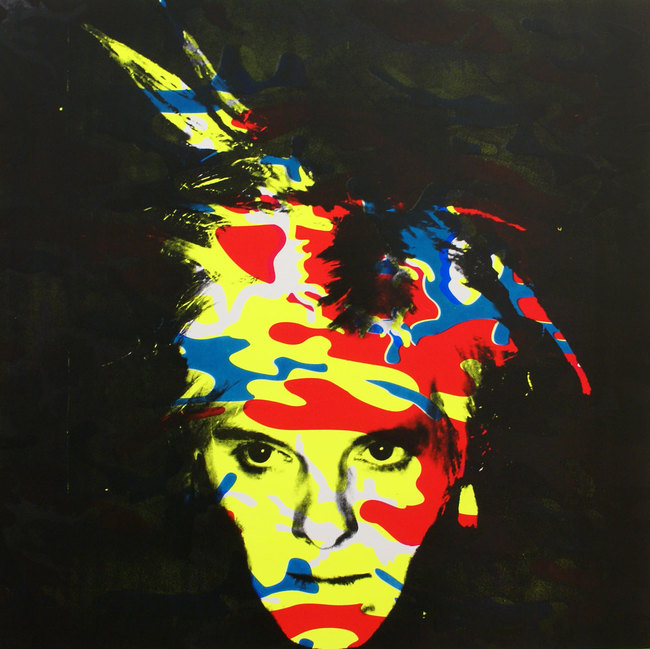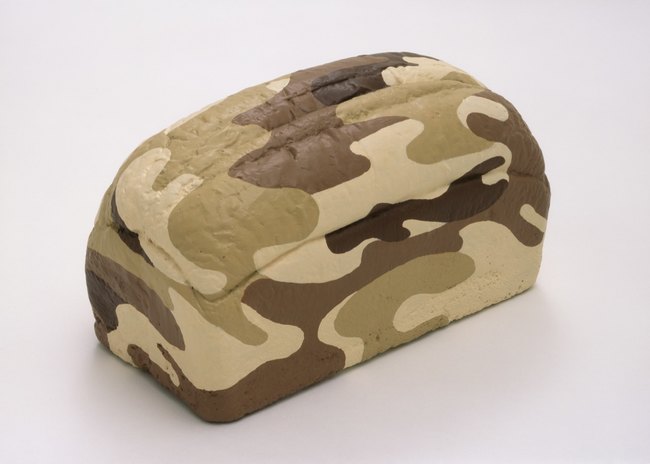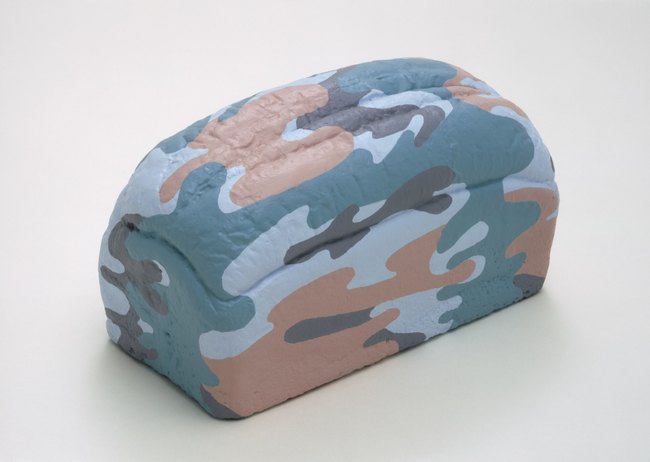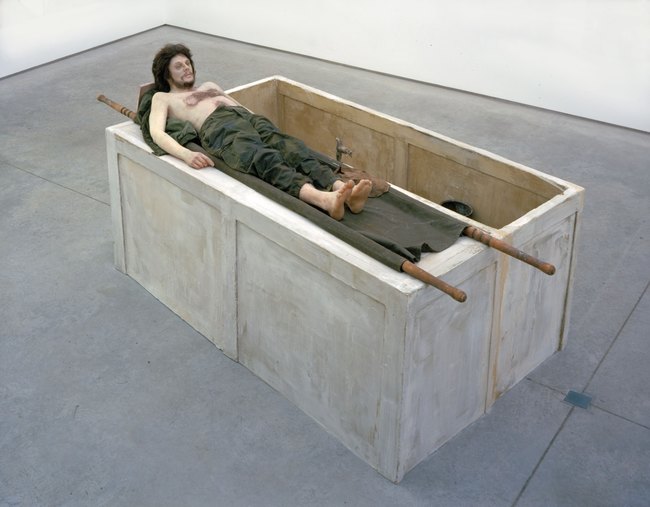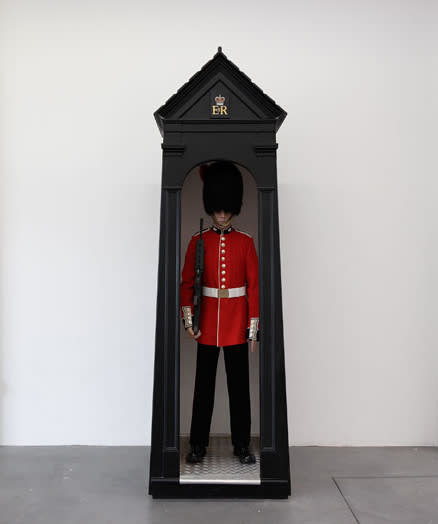AboutEssays2003This Is Not A Story About The Military
In 1909, when the Victorian naturalist and painter Abbott H. Thayer published his observations about concealment in nature, it’s fairly certain he had no idea what he was starting. Concealing Coloration in the Animal Kingdom was the first comprehensive catalogue of the many camouflage techniques employed in the natural world, and Thayer argued that nature was acting as an artist, creating optical effects with colour and light. On this basis he suggested that his study belonged in the realm of the artist as well as the naturalist. His thesis coincided with the birth of Cubism and, interestingly, with the emergence of Gestalt perceptual psychology. ‘Gestalt’ means ‘shape’ or ‘figure’, and its theorists sought to explore how the brain organizes and interprets visual material through form, context, spatial proximity and patterning. Perhaps unsurprisingly the primary concepts of Gestalt gained some credence within the art world, in particular with Klee and Kandinsky a decade or so later.
But it wasn’t just in the art world that significant changes were taking place. The early twentieth century saw a seismic shift in the visual techniques employed by military forces worldwide, primarily as a result of the development of longer range and more accurate weaponry. These new technological developments negated the traditional use of the military uniform, such as the famous red coat of the nineteenth century British army. The red coat had long been a symbol of military pride and was intended to visibly intimidate the enemy on the battlefield. But the trench warfare of World War One required different strategies. Colour on the battlefield was no longer used to inspire fear, but to conceal. In an unlikely meeting of opposites – the military and the arts – many modern painters were recruited into the army and given the task of using their new techniques, developed through the study of camouflage in nature, to disguise weapons, vehicles, and ultimately, men.
The French army led the way with its dedicated camouflage section under the direction of artist Lucien-Victor Guirand de Scevola and produced new innovations for concealment in the air, on land and at sea. The Cubists, many of whom fought in the Great War, and ever open to conceptual challenges, had already begun to reinterpret and mimic the camouflage techniques found in nature. It was Picasso who apparently first used the term ‘dazzle’, in reference to the need for warships to dazzle (i.e. ‘mislead’) their enemies at sea. Under the direction of British marine artist and Naval Commander Norman Wilkinson, the navy founded a ‘Dazzle Section’ based at the Royal Academy of Arts. Here a group of eighteen artists including Wilkinson and the Vorticist painter Edward Wadsworth developed paint schemes for warships that used disruptive patterns to confuse enemy gunners as to the target’s course, speed and direction. (In 2008 Jeff Koons showed a painted yacht, ‘Guilty’, that was directly inspired by the dazzle painted ships of WW1.)
The essential role of the artist as camoufleur continued in the Second World War, and by the time the war had ended, camouflage was deeply entrenched in twentieth century visual culture. New printing techniques had facilitated the mass production of army uniforms, and the development of international mass media in documenting war had brought camouflage into the public eye on a scale like never before. The first post-war artist to appropriate camouflage was the French painter Alain Jacquet. Exploring an interest in the visual effects of disruptive patterns, Jacquet created camouflage interpretations of his peers’ works, including Camouflage Jasper Johns (after John’s Flag, 1954) and Camouflage Hot Dog Lichtenstein, both in 1963. In 1964, Jacquet reinterpreted Manet’s Le Dejeuner sur l’herbe, which he described as breaking “reality into dots”, and thus having the same properties as camouflage. In 1964, Jacquet wore a camouflage suit recycled from a US Army parachute to the opening of his show at the Alexander Iolas Gallery in New York, attended by Andy Warhol and Roy Lichtenstein.
Italian artist Alighiero Boetti (1940-94) famously discovered surplus camouflage cloth (the ‘telo mimmetico’ pattern, created in 1929 for the Italian army) in a flea market. He used it to create works in 1966 and 1967, stretching the cloth as though it was a blank canvas and turning it into a visual artefact, thus subverting its original intention of concealment. The same decade saw the rise of the Civil Rights movement and the Anti-War response to Vietnam in America – the counter culture, in all its many manifestations, took to using army surplus as a new symbol of resistance to the Establishment, again subverting the purpose of camouflage from one of hiding to being seen, this time for political reasons.
It was newspaper coverage rather than surplus trade that led to Warhol’s re-appropriation of the US Army Woodland camouflage pattern in 1986 for his famous Camouflage series. Unlike Boetti, Warhol reworked the pattern’s original colourways and scale, although he left the shapes intact. Warhol used these camouflage patterns as a base for nearly 70 works including The Last Supper, Self Portrait and his portrait of Joseph Beuys. Warhol’s fascination with camouflage as a perfect form with which to explore the possibility of pure abstraction mirrored his own personal need for disguise. Perhaps it’s this central idea of disappearing, blending in, or inversely standing out, whether personally, socially, or politically, that makes camouflage so seductive to many artists. The lure of camo can be seen in modern works as diverse as the ‘pop’ camouflage of graffiti artist Leonard McGurr (Futura 2000) throughout the 80s, the architecturally camouflaged ‘Cloud Towers’ of Emile Aillaud in Paris, and the museum performances of Harvey Opgenorth in 1998, in which the artist stood in front of classic paintings by Matisse and Rothko wearing clothes that blended perfectly with the colours on the canvases.
More recently the idea of appropriation, the recycling (of theft?) of images has been at the heart of much contemporary artistic work that references camouflage. Gavin Turk’s 2007 exhibition ‘Me as Him’ projects both Turk and the Warhol, the men and the images, under a layer of silk-screened camouflage, challenging the idea of the self-portrait as something authentic with ‘deeper meaning’, and looking only to the façade for answers. Damian Hirst’s Amazing Revelations collage (2007) uses thousands of butterfly wings to make abstract patterns and inadvertently demonstrates some of the most skillful camouflage techniques used in nature. Hirst’s interest in butterflies as a metaphor for mortality is perhaps linked to the obvious visual use of camouflage as a survival mechanism.
Despite all of this, however, and despite the continued presence of camouflage in music, fashion and contemporary culture, the fact that the use of camouflage in the twentieth century developed through the synergy of nature and art is often overlooked. We could argue that its primary symbolic association is still with the military. Today, as more military special forces adopt black uniforms along with the use of new pixelated patterns in army camouflage, the traditional disruptive pattern – the khaki or sand uniforms that have become iconic cultural visual signifiers of war and combat for over a hundred years – becomes less useful. Does this mean that we will be able to culturally reclaim camouflage, divorcing its original artistic and natural function from military needs? Each time another artist uses the disruptive pattern in a non-military context, will this slowly reshape our perception on the meaning of camouflage? Perhaps eventually when we see a Warhol canvas or a rap album cover or a Japanese toy that uses a well-known camouflage pattern, it might be possible for us to respond to the colour, shape and form in its new context, without being dominated by the pattern’s prior historical military associations. We have to remember that the desire of Thayer or Braque or Picasso to explore the visual techniques found in natural forms was really a desire to understand themselves. The need to hide or to reveal oneself is not the same as the need to declare war.
